Sigma 17-40mm F1.8 DC Art Lens Review

The Sigma 17-40mm F1.8 DC Art Lens's focal length range and f/1.8 aperture combination make it extremely versatile. This pro-grade lens produces excellent image quality and is a great choice for general-purpose uses, including low-light scenarios, especially those involving people.
- Outstanding general-purpose utility, excellent choice for weddings, portraits, and events
- Sharp image quality
- F/1.8 aperture over the zoom range is awesome
- Professional grade
- Fast, silent, and smooth HLA AF
- 11-blade diaphragm
- Fixed compact size
- Control/aperture ring, customizable AFL buttons
- Affordable
- No optical stabilization
- Strong lateral CA at wide end
- Strong color blur at 40mm
- 40mm corners are slightly soft
Those looking for professional-grade performance from their APS-C camera must look no further.
The Sigma 17-40mm F1.8 DC Art Lens upholds the greatness its name implies. The trust garnered by the Sigma brands' long history of excellent design and quality assurance practices is followed by the extremely useful general-purpose 17-40mm zoom range, and the f/1.8 aperture over the entire focal length range is game-changing. DC indicates APS-C imaging sensor coverage, and the "Art" designation declares its professional-grade optical and mechanical performance, along with robust build quality. Fast and quiet AF, fixed size, and affordable price are not in the name, but those features are appreciated.
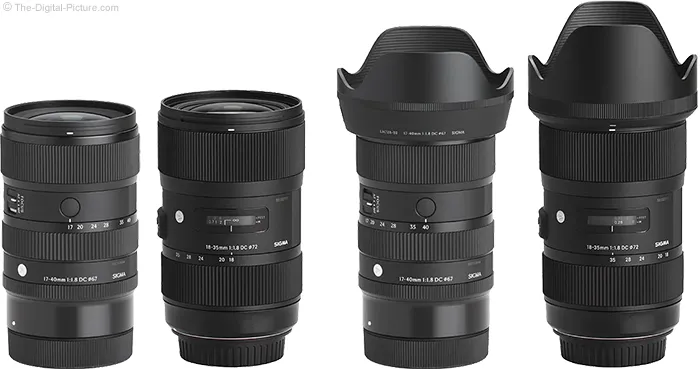
This is not the first such lens from Sigma. The 17-40mm F1.8 DC Art Mirrorless Lens improves upon its predecessor, the 18-35mm f/1.8 DC HSM Art Lens, one of the most popular DSLR lenses ever introduced. The word "groundbreaking" seemed inadequate for describing the awesomeness of that lens, featuring a not-before-seen-in-a-zoom-lens f/1.8 aperture. F/1.8 is 1 1/3 stops wider/faster than the f/2.8 of the zoom lens crowd, allowing more than twice as much light to reach the camera sensor as these alternatives, and closing the light transmission and background blur image quality gap vs. the f/2.8 on full-frame alternatives. The f/1.8 max aperture, available over the entire focal length range, put that zoom lens on a shelf by itself. Sigma called it the world's first.
Today, Canon and Sony offer f/2 full-frame zoom lenses, and Sigma has an f/1.8 full-frame zoom. Still, no Canon or Sony mount mirrorless APS-C zoom lens opens wider than f/2.8 except this one.
The Sigma 17-40mm F1.8 DC Art Lens will be on the best seller shortlist.
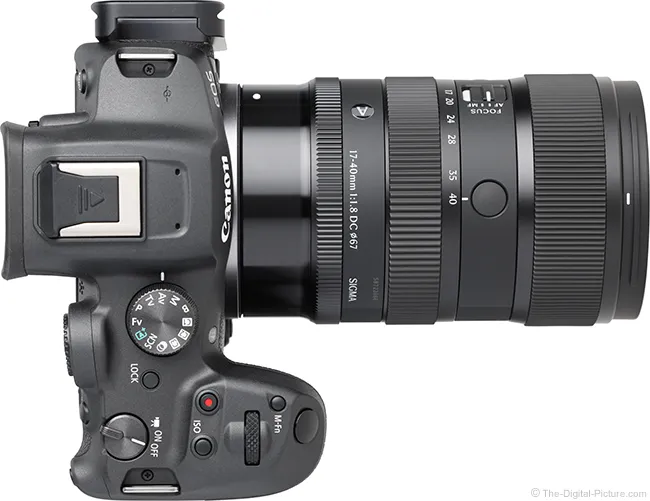
Focal Length Range
Back to TopFocal length range (or individual focal length for a prime lens) is a primary consideration for lens selection. A specific angle of view is required to get a desired subject framing with the optimal perspective (or from within a working distance limitation).
For those of us who think in full-frame angles of view, this lens frames like a 27.2-64mm full-frame Canon lens and 25.5-60mm for Sony. The moderately wide-angle through standard zoom range covers a significant percentage of general-purpose needs, making it an ideal option for photographing a vast range of subjects. This is the type of lens you can take when you are unsure which focal lengths you will need, and it will usually be the right choice.
The 17-40mm range is great for photographing people, including portraits, weddings, parties, events, documentaries, interviews, lifestyle, theater, fashion, studio portraiture, and even some sports. Use 40mm for portraits as tight as loose head and shoulders, and the wider end for groups and environmental imagery.

This is an ideal lens to leave mounted for candids around the house, such as a birthday celebration.
This lens is a great choice for media and photojournalistic needs, and for street photography.
This lens works superbly for landscape and cityscape photography, with compositions being ideally captured using the entire 17-40mm range. It is not difficult to create compelling landscape compositions using the 17mm perspective while still providing emphasis on a foreground subject against an in-focus background while providing the viewer a sense of presence in the scene. 40mm works well for slightly-compressed landscapes with distant subjects such as mountains.
With a wide aperture, this lens's range is attractive for photographing the night sky, with the 17mm end typically being of most interest in that regard.
This lens is well-suited for commercial photography, and the wide end of the range is ready to capture exterior architecture and larger interior spaces. Cityscapes, countrysides, flowers, medium and large products, and much more are in this lens's capabilities list.
The following images of Oliver in a tree stump in the rain illustrate the 17-40mm focal length range:

He went into contemplative mode before I could get the 40mm sample.
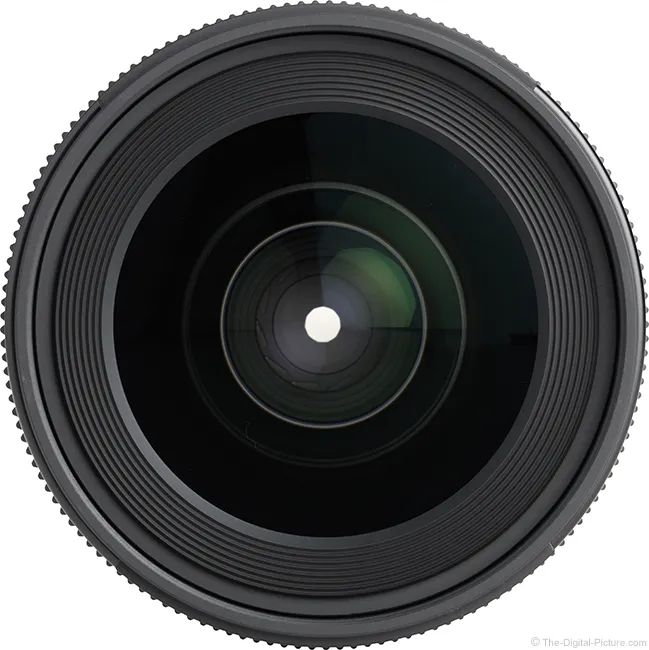
Max Aperture
Back to TopHaving f/1.8, a wide aperture typically found only in prime lenses, available throughout the 17-40mm range is awesome.
Wide apertures are useful for stopping action, both that of the subject and the camera, in low light levels while keeping ISO settings low. They also benefit AF systems, enabling them to work better in low-light environments.
Even when photographing under bright light conditions, wide apertures are useful for creating a strong background blur that clearly isolates a subject from even highly distracting backgrounds. These examples illustrate the maximum blur this lens can create:

For this focal length range in an APS-C lens, these results are great. Here is another set of examples that includes more apertures.

How does this lens's f/1.8 blur capability compare to the widest lens you have or are considering acquiring?
Especially with only APS-C coverage, this lens remains compact, lightweight, and affordable despite the wide aperture.
This lens features three rings. Except for the Canon RF mount version, the third ring controls the iris, which permits a manually selected aperture. The camera controls the aperture setting with the ring in the A (Auto) position, while all other settings electronically force the aperture to the chosen opening. A 2-position switch toggles the aperture ring between 1/3 stop clicks and smooth, quiet, non-clicked adjustments, ideal for video recording. The Iris Lock switch eliminates inadvertent aperture changes.
The Canon RF mount lens features a customizable clicked control ring.
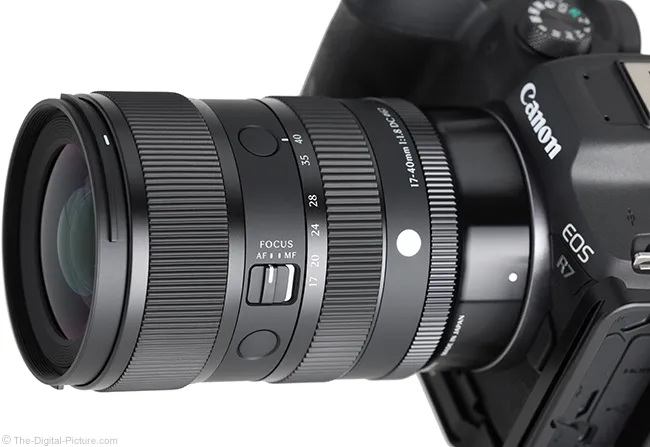
Image Stabilization
Back to TopThis lens's wide aperture considerably reduces the need for optical stabilization, along with its size, weight, complexity, and cost, and this lens does not have OS.
Still, with increasing ISO being the alternative, the noise difference IS enables for still subjects is huge, stabilization dramatically improves video quality, and sensor-based AF systems use the stabilized view for improved accuracy. Canon, in select EOS camera models, and Sony, in their Alpha series, address that omission with IBIS (In-Body Image Stabilization).
With no IS switch on the lens, the camera menu must be used to enable or disable IBIS or check the current settings. This extra step slightly impedes working quickly, moving from tripod mounted to handholding, for example.
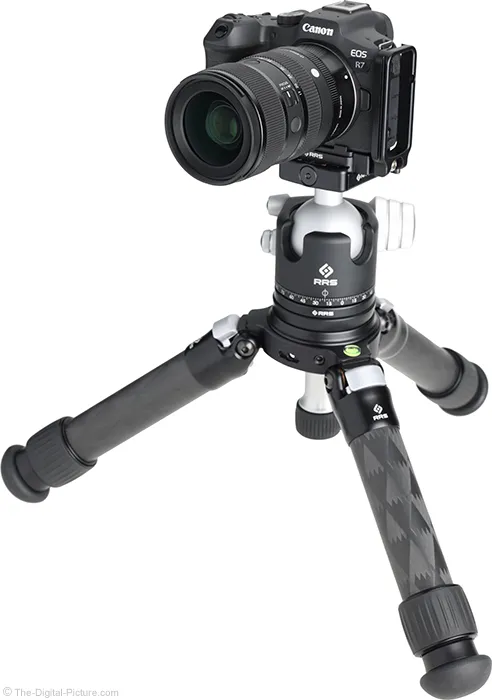
Image Quality
Back to TopThe 18-35mm f/1.8 DC HSM Art Lens set the image quality bar high, but despite having an increased focal length range, the 17-40mm F1.8 DC Art Lens cleared it.
This lens delivers excellent center-of-the-frame sharpness throughout the range. The test chart results appear slightly better at the wide end, but the slight difference in geometric distortion magnifying the resolution lines seems to bethe primary reason for the visual difference. Stopping down to f/2.8 results in only slight improvement, and none is needed.
Lenses typically produce decreased sharpness in the periphery of the image circle, where light rays are refracted to a stronger angle than in the center. At 17mm, this lens's corner image quality modestly trails the center results at f/1.8. Those results are good, but f/2.8 brings on impressive corner image quality.
At 28mm, the corners are impressively sharp at f/1.8, and stopping down yields little benefit aside from increased contrast resulting from decreased peripheral shading. The 40mm corner performance is like that at 17mm, with modestly less improvement at f/2.8.
The resolution chart is merciless on image quality, so let's take the testing outdoors, next looking at a series of center-of-the-frame 100% resolution crop examples. Taking the testing outdoors, we next look at a series of center-of-the-frame 100% resolution crop examples. These images were captured in RAW format by a Canon EOS R7 and processed in Canon's Digital Photo Professional (DPP) using the Standard Picture Style with sharpness set to 1 on a 0-10 scale. Note that images from most cameras require some level of sharpening; however, too-high sharpness settings are destructive to image details and mask the deficiencies of a lens.

These results are excellent.
Next, we'll examine a series of comparisons that show 100% resolution extreme top-left corner crops captured and processed identically to the above center-of-the-frame images. The lens was manually focused in the corner of the frame to capture these images.

Count on samples from the outer extreme of the image circle, full-frame corners, to show a lens's weakest performance. The 28mm corner results are outstanding. The 17mm f/1.8 results show some wide-open softness, but the f/2.8 performance is impressive. The 40mm results are also slightly soft, with f/2.8 bringing improvement, though not as much as at 17mm.
This lens does not exhibit focus shift, where the plane of sharp focus moves forward or backward as the aperture is narrowed, due to residual spherical aberration (RSA). Many modern lenses automatically correct for focus shift, though focus breathing (more later) can create slight angle of view changes.
When used on a camera that utilizes its full image circle, a lens is expected to exhibit peripheral shading at the widest aperture settings. This lens's wide-open shading ranges from just under 2 stops at 17mm to slightly over 2 stops at 40mm. Expect just under a stop of shading at f/2.8 and about half a stop at f/4 (just slightly more at 17mm). Further reductions at narrower apertures are minimal.
One-stop of shading is often considered the number of visibility, though subject details provide a widely varying amount of vignetting discernibility. Vignetting is correctable during post-processing, with increased noise in the brightened areas the penalty, or it can be embraced, using the effect to draw the viewer's eye to the center of the frame. Study the pattern shown in our vignetting test tool to determine how your images will be affected.
Lateral (or transverse) CA (Chromatic Aberration) refers to the unequal magnification of all colors in the spectrum. Lateral CA is characterized by color fringing along lines of strong contrast that run tangentially (meridionally, at right angles to radii). The mid and especially the periphery of the image circle exhibit the most significant amount, as this is where the greatest difference in wavelength magnification typically occurs. Lateral CA is usually easily correctable, often in the camera, by radially shifting the colors to coincide.
Color misalignment can be seen in the site's image quality tool, but let's also look at a set of worst-case examples. The images below are 100% crops from the extreme top-left corner of Canon EOS R7 frames showing diagonal black and white lines.

These images should only contain black and white colors, with the additional colors indicating lateral CA presence. The color separation is strong at the wide end, slowly decreases to negligible at 30mm, and increases slightly to modest at 40mm as the separated colors align and then reverse.
A relatively common lens aberration is axial (longitudinal, bokeh) CA, which causes non-coinciding focal planes of the various wavelengths of light. More simply, different colors of light are focused to different depths. Spherical aberration, along with spherochromatism, or a change in the amount of spherical aberration with respect to color (looks quite similar to axial chromatic aberration but is hazier) are other common lens aberrations to observe. Axial CA remains somewhat persistent when stopping down, with the color misalignment effect increasing with defocusing. The spherical aberration color halo exhibits little size change as the lens is defocused, and stopping down one to two stops generally removes this aberration.
In the real world, lens defects do not exist in isolation; spherical aberration and spherochromatism are generally found, at least to some degree, along with axial CA. These combine to create a less sharp, hazy-appearing image quality at the widest apertures.
The wide-open aperture examples below compare the fringing colors of the defocused specular highlights in the foreground to the background. The lens has introduced any differences from the neutrally colored subjects.

The 17mm through 30mm results look great, especially for f/1.8. However, the 40mm color blur is strong.
Bright light reflecting off lens elements' surfaces may cause flare and ghosting, resulting in reduced contrast and sometimes interesting, but usually objectionable, visual artifacts. The shape, intensity, and position of the flare and ghosting effects in an image are variable, dependent on the position and nature of the light source (or sources), selected aperture, shape of the aperture blades, and quantity and quality of the lens elements and their coatings. Additionally, flare and ghosting can impact AF performance.
This lens features Sigma's Super Multi-Layer Coating, and it produced practically no flare effects even at f/16 in our standard sun in the corner of the frame flare test, reflecting excellent performance.
Flare effects can be either embraced or avoided, or removal can be attempted, although this process can be challenging. Thus, this lens's high flare resistance is a welcome trait.
Two lens aberrations are particularly evident in images of stars, primarily because bright points of light against a dark background make them easier to discern. Coma occurs when light rays from a point of light spread out from that point instead of being refocused as a point on the sensor. Coma is absent in the center of the frame, gets worse toward the edges/corners, and generally appears as a comet-like or triangular tail of light that can be oriented either away from the center of the frame (external coma) or toward the center of the frame (internal coma). The coma clears as the aperture is narrowed. Astigmatism is seen as points of light spreading into a line, either sagittal (radiating from the center of the image) or meridional (tangential, perpendicular to sagittal). This aberration can produce stars appearing to have wings. Remember that Lateral CA is another aberration that is apparent in the corners.
The images below are 100% crops from the top-left corner of EOS R7 images captured at the widest available aperture.

A lens with an aperture this wide begs for night sky use, especially at 17mm. However, the 17mm corner results show strong triangular stretching. The 28mm corner stars have large wings, but the 40mm results are nice.
This lens has extreme barrel distortion at the wide end. The geometric distortion is so strong that Sigma forces correction in the camera (EVF, LCD, JPG images, movies), regardless of the lens correction settings.
Processing this lens's distortion test images with correction disabled reveals the true image captured. The squares in the test chart filled the viewfinder during capture. At 17mm, there is a lot of extra subject in the frame, and the straight line created by the top of the chart is rendered as a strong curve. This lens's barrel distortion rapidly diminishes as the focal length increases, transitioning into modest pincushion at 28mm and strong pincushion at 40mm.
Every lens is a compromise, and the reasons for designing a lens with uncorrected geometric distortion include lower cost, smaller size, lighter weight, reduced complexity, and improved correction of aberrations that are not software correctable. Geometric distortion can be corrected, including in-camera, using software and a correction profile, and once corrected, it is no longer a differentiator between lenses. However, the stretching required for correction can affect the final image quality. Base your evaluation on the corrected image quality shown throughout this review.
As seen earlier in the review, it is easy to illustrate the strongest blur a lens can create. Due to the infinite number of variables present among available scenes, assessing the blur quality, bokeh, is considerably more challenging. Here are some f/11 (for diaphragm blade interaction) examples.
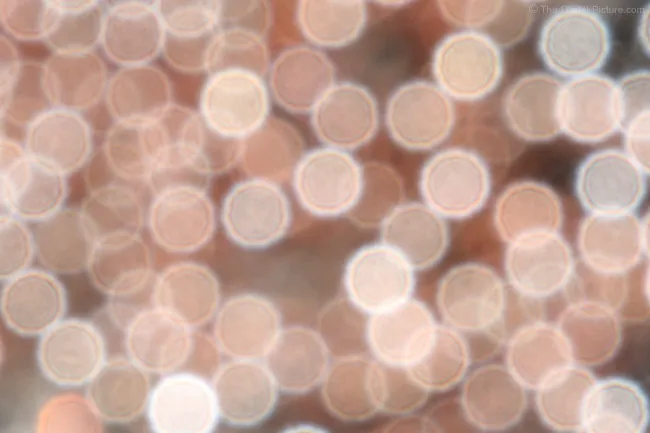
The first example shows defocused highlights that are rather smoothly filled and, thanks to 11 rounded aperture blades, quite round-shaped for the aperture closed by this large amount. In the second set of examples, the 17mm and 24mm results are 100% crops, and the 40mm sample is a full image reduced in size. All look great.
Except for a small number of specialty lenses, the wide aperture bokeh in the frame's corners does not show round defocused highlights, instead showing cat's-eye shapes due to a form of mechanical vignetting. If you look through a tube at an angle, similar to the light reaching the frame's corner, the shape is not round. That is the shape we're looking at here.

The truncation shown here is relatively minor. As the aperture narrows, the entrance pupil size is reduced, and the mechanical vignetting diminishes, making the corner shapes rounder.
An 11-blade diaphragm will create 22-point sunstars (diffraction spikes) from point light sources captured with a narrow aperture. Generally, the more a lens diaphragm is stopped down, the larger and better-shaped the sunstars tend to be. Wide aperture lenses tend to have an advantage in this regard, and this lens can produce beautiful stars, as illustrated below.

These examples were captured at f/16.
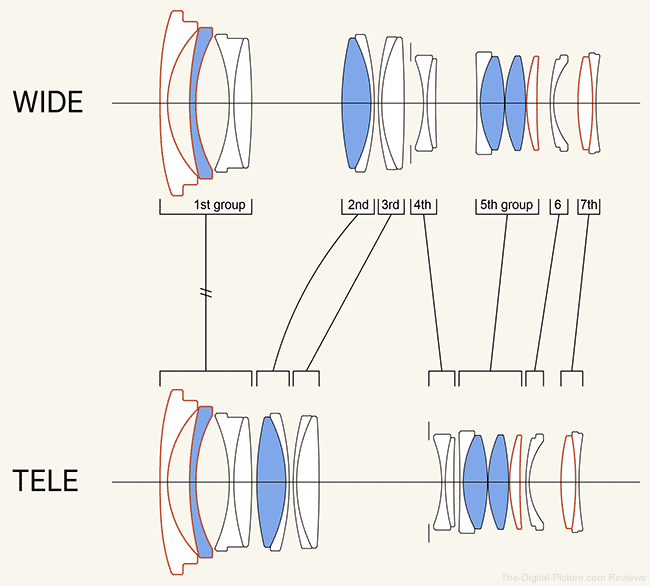
The optical design includes premium SLD glass (blue) and aspherical lenses (red).
Overall, the Sigma 17-40mm F1.8 DC Art Lens produces excellent image quality.
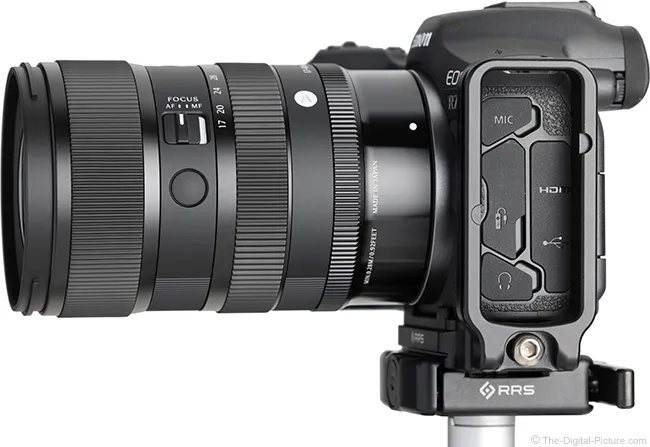
Focusing
Back to TopThe 17-40mm F1.8 DC Art Lens's HLA (High-response Linear Actuator) drives fast, nearly silent AF.
As usual, AF slows considerably in low light, but this lens's wide aperture enables it to lock AF on high contrast details in dark scenarios.
Non-cinema lenses typically require refocusing after a focal length change. As illustrated in the 100% crops below, the reviewed lens does not exhibit parfocal-like characteristics. When focused at 40mm, zooming to wider focal lengths results in focus blur.

If you adjust the focal length, re-establish focus.
Two customizable AFL (Autofocus Lock) buttons are provided in optimal locations for horizontal and vertical orientation. With the camera set to continuous focus mode, pressing AFL locks focus at the currently selected focus distance, enabling a focus and recompose technique. These buttons are customizable to another function using the camera's menu.
We can count on Sigma Art lenses to provide an outstanding manual focus experience. The large, strongly ribbed rubber focus ring is modestly raised from the lens barrel and is ideally positioned at the front of the lens, where it stays out of the way but remains easy to locate tactilely. The focus ring turns smoothly with ideal resistance, and the AF/MF switch makes this feature readily accessible.
A 300° slow rotation completes a full extent adjustment at 17mm, and 380° does the same at 40mm. Fast 140° and 380° rotations do the same.
It is normal for the scene to change size in the frame as the focus is pulled from one extent to the other. This effect is focus breathing, a change in focal length resulting from a change in focus distance. Focus breathing impacts photographers intending to use focus stacking techniques, videographers pulling focus (without movement to camouflage the effect), and anyone critically framing while adjusting focus.
This lens produces a modest change in subject size through a full-extent (worst-case) focus distance adjustment at 17mm and 28mm, and a minor change at 40mm.

This lens has a minimum focus distance of 11.0" (280mm), and at 40mm, it generates a respectable 0.21x maximum magnification spec.
| Model | Min Focus Distance | Max Magnification | |
|---|---|---|---|
| Canon RF-S 18-45mm F4.5-6.3 IS STM Lens | 7.9" | (200mm) | 0.26x |
| Sigma 17-40mm F1.8 DC Art Lens | 11.0" | (280mm) | 0.21x |
| Sigma 18-35mm f/1.8 DC HSM Art Lens | 11.0" | (280mm) | 0.23x |
| Sigma 18-50mm F2.8 DC DN Contemporary Lens | 4.8" | (121mm) | 0.36x |
| Sigma 24-70mm F2.8 DG DN II Art Lens | 6.7" | (170mm) | 0.37x |
| Sony E 16-55mm F2.8 G Lens | 13.0" | (330mm) | 0.20x |
At 17mm, a subject measuring approximately 5.6 x 3.7" (142 x 95mm) fills the imaging sensor at this lens's minimum MF distance, and at 40mm, a 4.7 x 3.3" (119 x 79mm) subject does the same. Here are maximum magnification examples.

The individual USPS love stamps measure 1.19 x 0.91" (30 x 23mm).
While this lens produces sharp center-of-the-frame details at minimum focus distance with a wide-open aperture, expect the image periphery to be soft due to field curvature. F/11 brings on increased depth of field and significantly improved corner image quality.
The minimum focus distance is measured from the imaging sensor plane, with the balance of the camera, lens, and lens hood lengths taking their space out of the number to create the working distance. Obtaining the maximum magnification at the 40mm measured minimum focus distance of 10.3" (262mm) places the plane of sharp focus only about 4.9" (mm) in front of the lens without the hood mounted, and at this distance, the lens can obstruct the subject lighting. At 17mm, the maximum magnification working distance is reduced to only about 3.3" (84mm) in front of the lens hood. Installing the hood further reduces working space and increases obstruction of the subject lighting.
This lens is not compatible with Sigma, Canon, or Sony teleconverters.
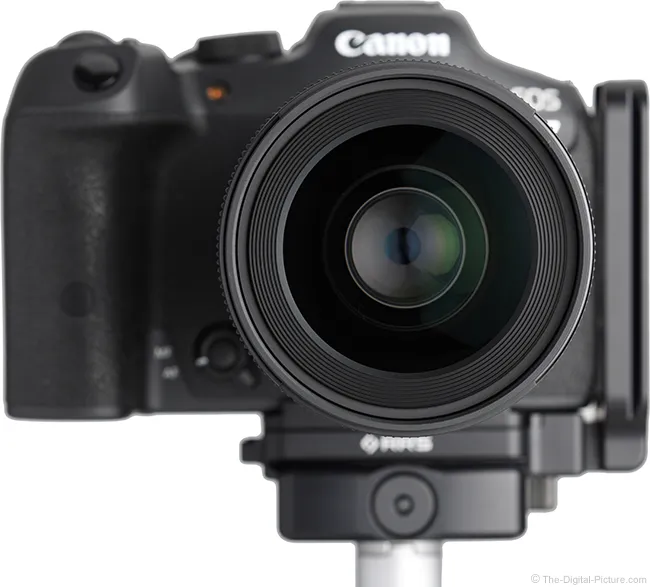
Design & Features
Back to TopSigma Art lenses always feature a great physical design, including professional-grade construction and attractive aesthetics.
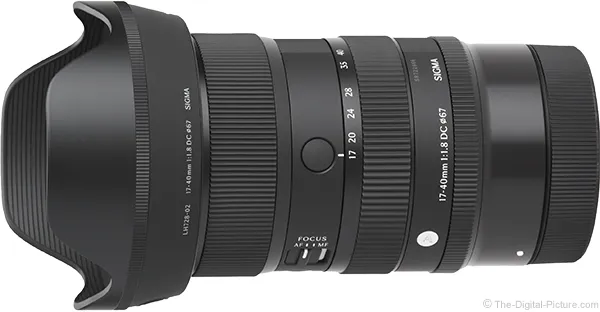
The Sigma 17-40mm F1.8 DC Art Lens features a TSC (Thermally Stable Composite) exterior. "TSC is a state-of-the-art polycarbonate that is designed to be both lightweight and extremely durable, and its chemical makeup means it doesn't shrink or expand with changing temperatures. This material is so high-quality that we're also incorporating it into our Art and Sports lenses to provide lightness and thermal consistency." [Sigma]
This lens features a relatively straight design, with the ribs of the three rings raised slightly outward from the lens barrel. Two small sections of the lens barrel are fixed with about 180° of molded plastic ribs for enhanced grip.
The slightly small but easy-to-use rubber ribbed zoom ring is ideally positioned, and the short 65° rotation is ideal for this focal length range. This ring turns in the same direction as Canon's zoom lenses and opposite that of Sony's lenses.
The third ring, a control ring for the Canon RF mount and aperture ring for the others, has molded plastic ribs, which are not as grippy as rubber variants.
The 17-40mm F1.8 DC Art Lens features a fixed size. As the focal length is increased, the lens remains the same length and, as shown in the lens design illustration earlier in this review, maintains the same balance. A zoom lock switch is not provided or needed.
Raised switch panels have gone out of style, and Sigma's typical raised switch bank is gone. The flush-mounted switch is a nice improvement. The center of the AF/MF is raised just enough for use with gloves, and this 2-position switch snaps crisply into position, showing a white background when in the AF position.

Like most Art lenses, this one is dust and moisture resistant.
The front lens element has a fluorine coating that repels fingerprints, dust, water, oil, and other contaminants and makes cleaning considerably easier.
There are no direct comparable lenses, so this size and weight comparison chart will feature class extension.
| Model | Weight oz(g) | Dimensions w/o Hood "(mm) | Filter | Year | ||
|---|---|---|---|---|---|---|
| Canon RF-S 18-45mm F4.5-6.3 IS STM Lens | 4.6 | (130) | 2.7 x 1.7 | (68.9 x 44.3) | 49 | 2022 |
| Sigma 17-40mm F1.8 DC Art Lens | 19.8 | (560) | 2.9 x 4.6 | (72.9 x 115.9) | 67 | 2025 |
| Sigma 18-35mm f/1.8 DC HSM Art Lens | 28.6 | (811) | 3.1 x 4.8 | (78.0 x 121.0) | 72 | 2013 |
| Sigma 18-50mm F2.8 DC DN Contemporary Lens | 10.2 | (290) | 2.5 x 2.9 | (64.5 x 74.5) | 55 | 2017 |
| Sigma 24-70mm F2.8 DG DN II Art Lens | 26.3 | (745) | 3.5 x 4.7 | (87.8 x 120.2) | 82 | 2024 |
| Sony E 16-55mm F2.8 G Lens | 17.4 | (494) | 2.9 x 3.9 | (73.0 x 100.0) | 67 | 2019 |
View and compare the complete Sigma 17-40mm F1.8 DC Art Lens Specifications in the site's lens specifications tool.
Here is a visual comparison:
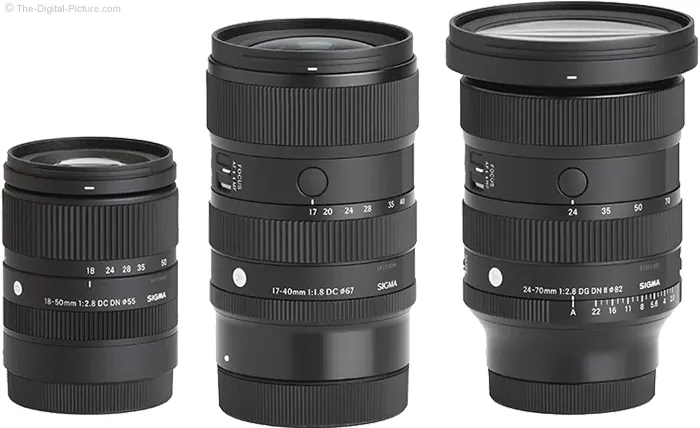
Positioned from left to right are the following Sigma lenses:
18-50mm F2.8 DC DN Contemporary
17-40mm F1.8 DC Art
24-70mm F2.8 DG DN II Art
Note that the Canon RF mount and lens cap are larger than the Sony E mount lenses in this comparison.
The same lenses are shown below with their hoods in place.
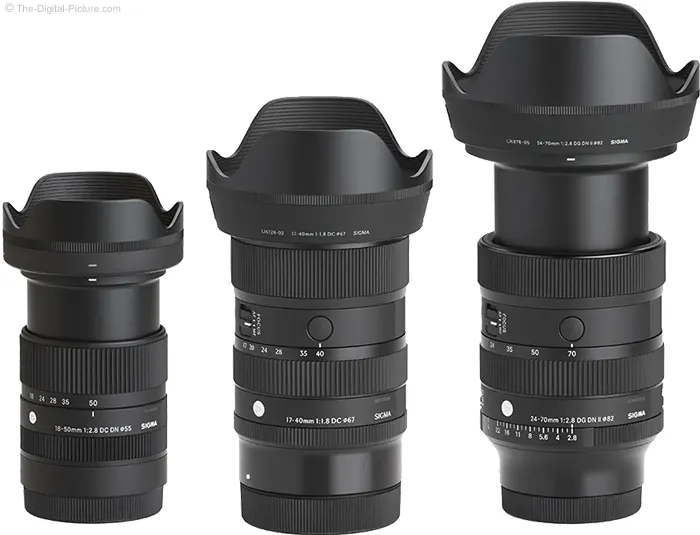
Use the site's product image comparison tool to visually compare the Sigma 17-40mm F1.8 DC Art Lens to other lenses.
This lens is compatible with super common, modestly sized, affordable 67mm filters. As is more normal with barrel-distortion-corrected lenses, a standard-thickness circular polarizer filter does not significantly increase wide-aperture peripheral shading. Still, a slim model such as the Breakthrough Photography X4 is recommended.
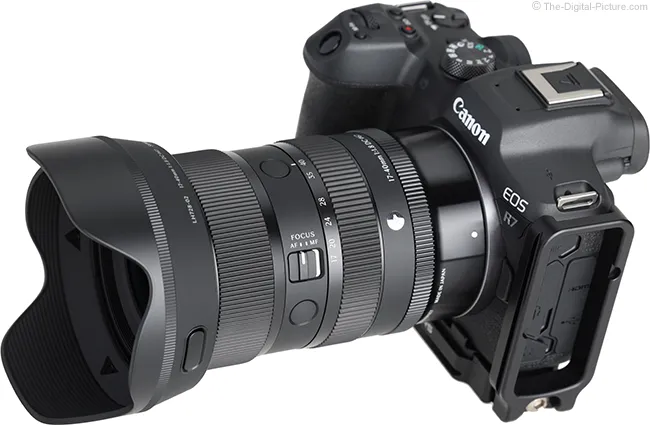
Sigma always includes the lens hood in the box, and this lens comes with the LH-728-02 lens hood. This is a semi-rigid plastic petal-shaped hood with a ribbed interior designed to avoid reflections. A thin ribbed ring and rubberized rear section provide a sure grip, and the push-button release makes installation and removal easy. This hood offers significant protection from both impact and, especially at the widest focal lengths, bright light.
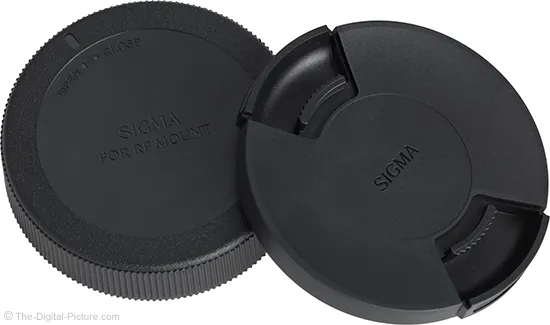
Price, Value, Compatibility
Back to TopIs the Sigma 17-40mm F1.8 DC Art Lens worth the price? While this lens is priced relatively high for APS-C-only image circle coverage, it is modestly priced overall, and its quality, performance, and utility make it easily worth the cost. If the kit of prime lenses the 17-40 can replace is considered, this lens is a great deal.
The "DC" in the name indicates that this lens provides an image circle wide enough to cover only an APS-C imaging sensor. Full-frame imaging sensor models will automatically switch into APS-C mode when an APS-C lens is mounted, and mounting this lens on a full-frame camera can make sense. The Sigma 17-40mm F1.8 DC Art Lens is available in Canon RF, Sony E, Leica L, and Fujifilm X mounts.
Made in Japan, each Art lens is tested with Sigma's proprietary MTF measuring system, ensuring a quality product. Sigma develops, manufactures, and sells the E-mount version of this lens based on the specifications of the E-mount, disclosed by Sony Corporation under license agreement. "This product is developed, manufactured, and sold under license from Canon Inc." [Sigma]
Sigma provides a 1-year limited warranty, and Sigma Corporation of America provides a limited 3-year warranty extension.
The reviewed Sigma 17-40mm F1.8 DC Art Lens in RF mount was on loan from Sigma.
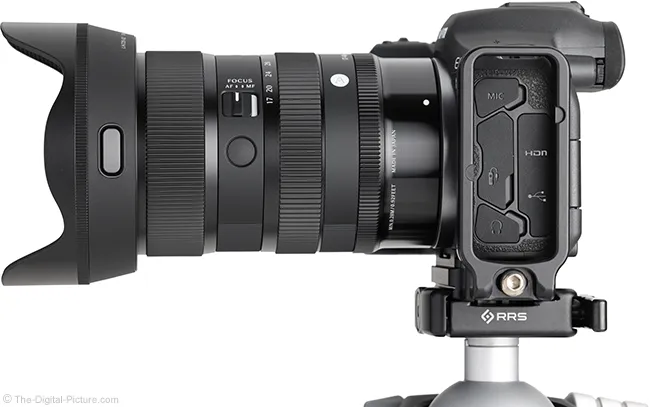
Alternatives
Back to TopThe perfect lens does not exist. However, the best lens for your needs does. Determining that answer requires a look at the alternatives. This lens's predecessor, the highly-regarded and ultra-popular Sigma 18-35mm f/1.8 DC HSM Art Lens, is adaptable to other popular mounts, making it an especially good alternative to compare.
In the image quality comparison, the improved optical design of the 17-40 proves itself slightly sharper, even when tested on the ultra-high resolution 32.5 MP R7 vs. the 18.0 MP 60D. The 18-35 shows slightly less peripheral shading and considerably less geometric distortion. The 17-40 has a significantly improved flare resistance.
The Sigma 17-40mm F1.8 DC Art vs. 18-35mm f/1.8 DC HSM Art Lens comparison shows the 17-40 weighing a noticeable 8.8 oz (251g) less and measuring modestly less, despite its longer focal length range. The 17-40 has 11 aperture blades vs. 9, HLA AF vs HSM, a control/aperture ring, two AFL buttons, and no raised AF/MF switch panel. The 17-40 is more expensive but worth the upgrade.
If the f/1.8 aperture is not advantageous to you, the 1 1/3 stop darker Sigma 18-50mm F2.8 DC DN Contemporary Lens becomes an alternative.
In the image quality comparison, the two lenses perform similarly, each with slight advantages. As expected, the f/1.8 lens shows less peripheral shading at f/2.8. The 18-50 has less geometric distortion at the wide end.
The Sigma 17-40mm F1.8 DC Art vs. 18-50mm F2.8 DC DN Contemporary Lens comparison shows the 18-50 considerably smaller and lighter, though it is an extending lens, which reduces some of the length difference when zoomed in. The 17-40 has 11 aperture blades vs. 7, HLA AF vs a stepping motor, a control/aperture ring, two AFL buttons, and an AF/MF switch. The 18-50 has a 0.36x maximum magnification spec vs. 0.21x, uses 55mm filters vs. 67mm, and is considerably less expensive. The focal length ranges are different.
At review time, the E 16-55mm F2.8 G is Sony's premium general-purpose APS-C lens. The Sony lens has a considerably wider zoom range, but f/2.8 is considerably narrower than f/1.8.
In the wide-open image quality comparison, the Sony lens is slightly sharper in the wide and mid focal lengths. The Sigma lens has a slight sharpness advantage at 40mm. The Sigma lens shows slightly reduced flare effects and less peripheral shading at 17mm f/2.8 (which shows good performance by the Sony lens). The Sony lens has more substantial barrel distortion at the wide end and less pincushion distortion at the long end.
The Sigma 17-40mm F1.8 DC Art Lens vs. Sony E 16-55mm F2.8 G Lens comparison shows the Sigma lens slightly longer than the retracted Sony lens but shorter than that lens fully extended. The Sony lens is slightly lighter. The Sigma lens 11 aperture blades vs. 9, an aperture ring, and two AFL buttons vs. 1. Both lenses are great options, but the significantly higher price of the Sony lens will surely affect some decisions.
Use the site's tools to create additional comparisons.
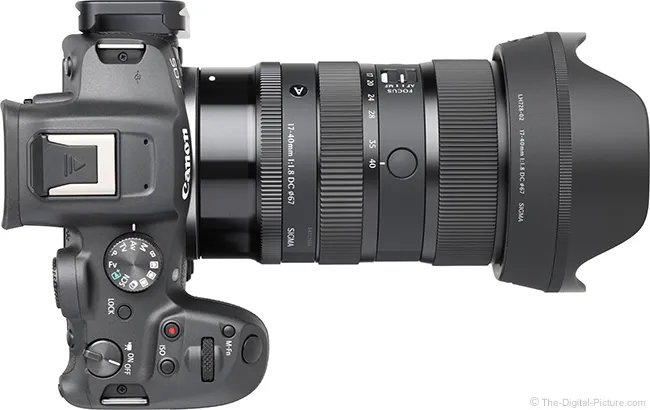
Summary
Back to TopThe Sigma 17-40mm F1.8 DC Art Lens features a high utility focal length range, an extremely wide f/1.8 aperture over the entire range, and excellent image quality, including at f/1.8. This lens has the full professional treatment, including excellent design and build quality, and high-performing HLA AF.
On top of many of its other ideal uses, this lens is an especially outstanding choice for photographing people, including at weddings, events, close-distance sports, and around the house, and it is a top choice for anyone looking for professional-grade performance from an APS-C format camera.
Bringing you this site is my full-time job (typically 60-80 hours per week). Thus, I depend solely on the commissions received from you using the links on this site to make any purchase. I am grateful for your support! - Bryan

Review Date: 2025-06-16
